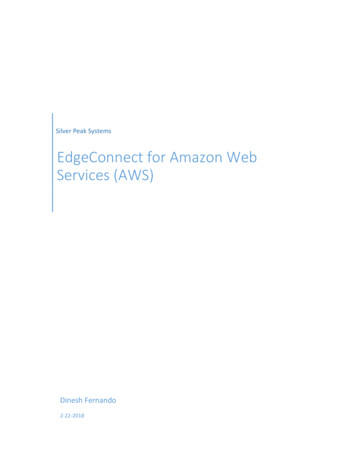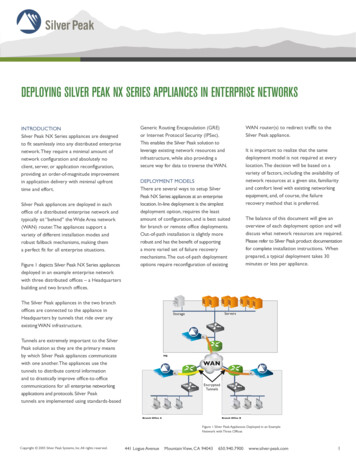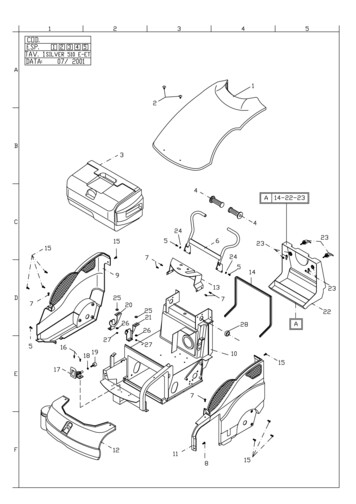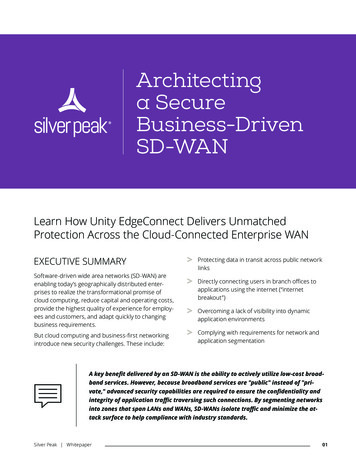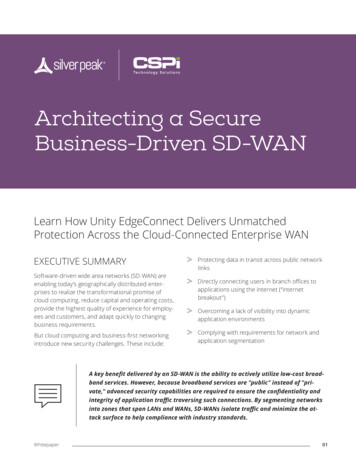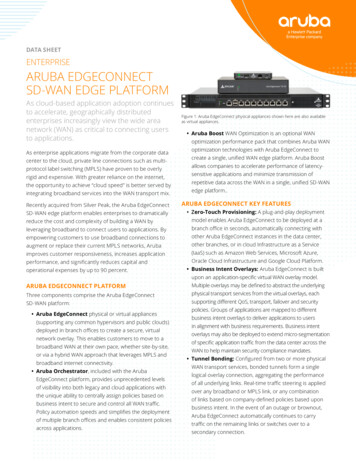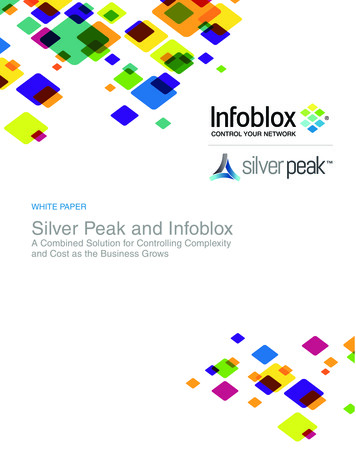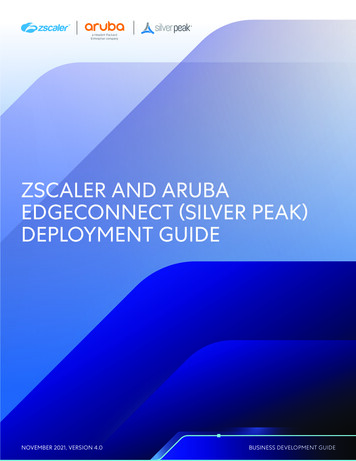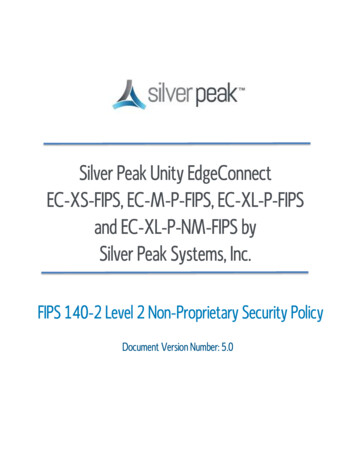
Transcription
Silver Peak Unity EdgeConnectEC-XS-FIPS, EC-M-P-FIPS, EC-XL-P-FIPSand EC-XL-P-NM-FIPS bySilver Peak Systems, Inc.FIPS 140-2 Level 2 Non-Proprietary Security PolicyDocument Version Number: 5.0
Table of Contents1.Module Overview . 32.Modes of Operation. 52.1 Approved Cryptographic Functions . 62.2 Non-FIPS Approved But Allowed Cryptographic Functions. 83.Ports and interfaces . 94.Roles, Services and Authentication . 115.Cryptographic Keys and CSPs . 136.Self-tests. 157.Physical Security . 168.References. 21This document can be freely distributed in its entirety without modificationPage 2
1. Module OverviewUnity EdgeConnect appliances deliver predictable application performance over any combination oftransport services. Orchestrated application-driven security policies enable direct internet breakout fortrusted SaaS and web applications. Fully compatible with existing WAN infrastructure, EdgeConnectprovides simplifies and enables the Thin Branch.Unity EdgeConnect appliances are deployed in branch offices to create a secure, virtual network overlay.This enables customers to move to a broadband WAN at their own pace, whether site-by-site, or via ahybrid WAN approach that leverages MPLS and broadband internet connectivity.Unity Boost is a performance pack that combines Silver Peak WAN optimization technology withEdgeConnect to create a high performance SD-WAN solution. Boost allows companies to accelerateperformance of latency-sensitive applications and minimize transmission of repetitive data across theWAN in a single, fully integrated SD-WAN solution.Figure 1: Silver Peak EdgeConnectFIPS 140-2 conformance testing was performed at Security Level 2. The following configurations weretested by the lab.Table 1: Configurations tested by the labModule Name and VersionFirmware versionEC-XS-FIPS P/N 201447-001EC-M-P-FIPS P/N 201634-001EC-XL-P-FIPS P/N 201449-001EC-XL-P-NM-FIPS P/N 210659-0018.1.9.78.1.9.78.1.9.78.1.9.7This document can be freely distributed in its entirety without modificationPage 3
The Cryptographic Module meets FIPS 140-2 Level 2 requirements.Table 2: Module Security Level StatementFIPS Security AreaCryptographic Module SpecificationModule Ports and InterfacesRoles, Services and AuthenticationFinite State ModelPhysical SecurityOperational EnvironmentCryptographic Key ManagementEMI/EMCSelf-testsDesign AssuranceMitigation of Other AttacksSecurity Level22222N/A2222N/AThe module is multi-chip standalone hardware.The cryptographic boundary of the module is the enclosure that contains components of the module.The enclosure of the cryptographic module is opaque within the visible spectrum. The module usestamper evident labels to provide the evidence of tampering.Figure 2: EC-XS-FIPSThis document can be freely distributed in its entirety without modificationPage 4
Figure 3: EC-M-P-FIPSFigure 4: EC-XL-P-FIPS/EC-XL-P-NM-FIPSNote: EC-XL-P-NM-FIPS has additional storage to improve performance.2. Modes of OperationThe module is intended to always operate in the FIPS approved mode.The Crypto Officer must invoke the user interface using default password (“admin”). Crypto Officer willbe forced to change the default password during the installation.This document can be freely distributed in its entirety without modificationPage 5
Configuring or enabling any of the following takes the device out of FIPS mode. Configuring the device in legacy router mode, in-line bridge mode, or server mode SSL acceleration, configurable in the following locations: Optimization Policy template Optimization Policy rules Boost feature SaaS optimization, configurable in the following locations: SaaS optimization template SaaS optimization configuration tab SNMP v1 and v2 HTTP for webUI Third-party IPsec tunnels with NULL IPsec encryption, use any non-NULL encryption instead ‘IPsec UDP’ mode under Orchestrator- Tunnel Settings. Use ‘IPsec’ mode instead (‘IKE’ isimplicitly enabled)If any of these features are enabled, you are no longer in FIPS mode, nor can you revert to FIPS mode. Inthis case, you must return the device and receive a fresh device from our factory.2.1 Approved Cryptographic FunctionsThe following approved cryptographic algorithms are used in FIPS approved mode of operation.Table 3: Approved Cryptographic FunctionsCAVPCertLibraryAlgorithmC1204Silver PeakAESCryptographiclibraryC1201Silver PeakAES-NICryptographiclibraryStandardFIPS 197,SP 800-38D,SP 800-38FModel/MethodKey Lengths,Curves or ModuliECB, CBC, CTR,GCM1128, 192, 256CBC128, 256This document can be freely distributed in its entirety without modificationUseData Encryption/DecryptionKTS (AES Cert.#C1204 andHMAC Cert.#C1204; keyestablishmentmethodologyprovides 128 or256 bits ofencryptionstrength)Page 6
CAVPCertLibraryAlgorithmStandardModel/MethodSP 800-90ACounter withAES 256Key Lengths,Curves or ModuliUseC1204Silver PeakDRBGCryptographiclibraryC1204CVLSilver PeakSP 800-56ACryptographic Partial DHlibraryECCP-224, P-256,P-384, P-521,K-233, K-283,K-409, K-571,B-233, B-283,B-409, B-571Shared SecretComputationC1204Silver PeakHMACCryptographiclibraryFIPS 4HMAC-SHA-512160, 256, 224,384, 512MessageAuthenticationC1204Silver PeakSHSCryptographiclibraryFIPS 180-4SHA-1SHA-224SHA-256SHA-384SHA-512C1204Silver PeakRSACryptographiclibraryFIPS 186-4FIPS 186-2PKCS1 cRandom BitGeneration2Message DigestRSA KeyGen(186-4) 2048,3072Digital SignatureGeneration andVerificationRSA SigGen(186-4) 2048,3072Key GenerationRSA SigGen(186-2) 4096RSA SigVer(186-2) 10244,1536, 2048,3072, 4096This document can be freely distributed in its entirety without modificationPage 7
CAVPCertLibraryAlgorithmCVLSilver PeakCryptographic TLS dardModel/MethodKey Lengths,Curves or ModuliUseSP 800-135Key Derivation5CryptographicKeyGenerationKey Generation6Note 1: Not all CAVS-tested modes of the algorithms are used in this module.Note 2: Any firmware loaded into this module that is not shown on the module certificate, is out of thescope of this validation and requires a separate FIPS 140-2 validation.1The module’s AES-GCM implementation complies with IG A.5 scenario 1 and RFC 5288, and supportsacceptable GCM cipher suites from Section 3.3.1 of SP 800-52 Rev 1 or SP 800-52 Rev 2. AES-GCM is onlyused in TLS version 1.2. When the IV exhausts the maximum number of possible values for a givensession key, the first party, client or server, that encounters this condition will trigger a handshake toestablish a new encryption key. New AES-GCM keys are generated by the module if the module losespower.2The minimum number of bits of entropy generated by the module is 256 bits.3SHA-1 is only allowed and CAVS tested in RSA Signature Verification for legacy use. It is not used forSignature Generation.41024-bit key is only allowed and CAVS tested in RSA Signature Verification for legacy use.5No parts of these protocols, other than the KDF, have been tested by the CAVP and CMVP.6The module directly uses the output of the DRBG.2.2 Non-FIPS Approved But Allowed Cryptographic Functions.Table 4: Non-FIPS Approved But Allowed Cryptographic FunctionsAlgorithmRSA Key Wrapping using 2048 bits keyCaveatProvides 112 bits of encryptionstrength.This document can be freely distributed in its entirety without modificationUseUsed for key establishmentin TLS handshake.Page 8
AlgorithmCaveatEC DH using 224 / 256 / 384 / 521 bits keyProvides between 112 and 256bits of encryption strengthProvides 112 bits of encryptionstrength.DH using 2048 bits keyNDRNGUseUsed for key establishmentin TLS handshake.Used for key establishmentin SSH handshake.Used to seed SP 800-90ADRBG.3. Ports and interfacesThe following table describes physical ports and logical interfaces of the module.Table 6.1: Ports and Interfaces of EC-XS-FIPSPort NameCountInterface(s)Management Ports:10/100/1000 Ethernet Ports2Data Input, Data Output, Control Input, Status OutputNetwork Ports:10/100/1000 Ethernet Ports4Data Input, Data Output, Control Input, Status OutputLEDs12Status OutputPower Button1Control InputPower Jack1Power InputReset Button1Not UsedConsole Port1Not UsedUSB Ports2Not UsedThis document can be freely distributed in its entirety without modificationPage 9
Table 6.2: Ports and Interfaces of EC-M-P-FIPSPort NameCountInterface(s)Management Ports:10/100/1000 Ethernet Ports2Network Ports:10/100/1000 Ethernet Ports4Network Ports:10/1G Fiber Ethernet Ports2LEDs20Status OutputPower Receptacle2Power InputConsole Port1Not UsedVideo Port2Not UsedUSB Ports2Not UsediDRAC Port1Not UsedData Input, Data Output, Control Input, Status OutputTable 6.3: Ports and Interfaces of EC-XL-P-FIPS/EC-XL-P-NM-FIPSPort NameManagement Ports:10/100/1000 Ethernet PortsCountInterface(s)2Data Input, Data Output, Control Input, Status OutputNetwork Ports:10/1G Ethernet Fiber Ports4LEDs16Status OutputPower Receptacle2Power InputConsole Port1Not UsedVideo Port2Not UsedUSB Ports2Not UsedThis document can be freely distributed in its entirety without modificationPage 10
iDRAC Port1Not Used4. Roles, Services and AuthenticationThe module supports role-based authentication. The module supports a Crypto Officer role and a UserRole. The Crypto Officer installs and administers the module. The Users use the cryptographic servicesprovided by the module. The module supports concurrent operators. The module provides the followingservices.Table 7.1: Roles and ServicesServiceRun Self-test1Reboot1ZeroizeFirmware updateShow status1SSH connectCorrespondingRolesCrypto OfficerUserCrypto OfficerUserCrypto OfficerCrypto OfficerCrypto OfficerUserCrypto OfficerUserConfigurationCrypto OfficerAppliance webUIIPsec connectCrypto OfficerUserCrypto OfficerUserCrypto OfficerRemote resetCrypto OfficerSNMPv3Types of Access to Cryptographic Keys and CSPsR – ReadE - ExecuteW – Write or CreateZ – ZeroizeN/AN/AAll: ZFirmware update key: R, EN/APassword: R, WSSH Keys: R,W, EDRBG seed: R, WPassword: R, WSSH Keys: R,W, ETLS Keys: R,W, EDRBG seed: R, WTLS Keys: R,W,EDRBG seed: R, WPassword: R, WSNMP Keys: R,W,EIPsec Keys: R,W,EDRBG seed: R,WTLS Keys: R,W,EDRBG seed: R, WThis document can be freely distributed in its entirety without modificationPage 11
ServiceNetwork Memory1CorrespondingRolesCrypto OfficerUserTypes of Access to Cryptographic Keys and CSPsR – ReadE - ExecuteW – Write or CreateZ – ZeroizeIPsec Keys: R,W,EDRBG seed: R,WWhile performing these services, the operator is not required to assume an authorized role.The module supports the following authentication mechanisms.Table 7.2: Authentication MechanismsRoleUser Role (read-only user)Authentication MechanismsPassword:The module uses passwords of at least 8 printablecharacters and must contain the following items:one upper case letter, one lower case letter, anumber, and a special character. The total numberof password character combinations with eightcharacters is95 4*26*26*10*33 17,416,947,799,680.Therefore the probability is less than one in1,000,000 that a random attempt will succeed or afalse acceptance will occur.The appliance rate limits failed password attemptsto four per minute. Therefore for multipleattempts to use the authentication mechanismduring a one-minute period, the probability is lessthan one in 100,000 that a random attempt willsucceed or a false acceptance will occur.CO Role (configuration user)Password:The module uses passwords of at least 8 printablecharacters and must contain the following items:one upper case letter, one lower case letter, anumber, and a special character. The total numberof password character combinations with eightcharacters is95 4*26*26*10*33 17,416,947,799,680.Therefore the probability is less than one inThis document can be freely distributed in its entirety without modificationPage 12
RoleAuthentication Mechanisms1,000,000 that a random attempt will succeed or afalse acceptance will occur.The appliance rate limits failed password attemptsto four per minute. Therefore for multipleattempts to use the authentication mechanismduring a one-minute period, the probability is lessthan one in 100,000 that a random attempt willsucceed or a false acceptance will occur.IPSec PSK:The module uses IPSec PSK of at least 8 printablecharacters. The total number of IPSec PSKcharacter combinations is at least 62 8 218,340,105,584,896. Therefore the probability isless than one in 1,000,000 that a random attemptwill succeed or a false acceptance will occur.The time necessary for one IKE handshake limitsthe number of IKE handshakes in 1 minute toabout 2000. Thus, for multiple attempts to use theauthentication mechanism during a one-minuteperiod, the probability is less than one in 100,000that a random attempt will succeed or a falseacceptance will occur.5. Cryptographic Keys and CSPsThe table below describes cryptographic keys and CSPs used by the module.Table 8: Cryptographic Keys and CSPsKeyTLS master secretTLS pre-master secretTLS AES keyDescription/UsageUsed to derive TLS encryptionkey and TLS HMAC KeyUsed to derive TLS mastersecretUsed during encryption anddecryption of data within theTLS protocolStorageRAM in plaintextRAM in plaintextRAM in plaintextThis document can be freely distributed in its entirety without modificationPage 13
KeyTLS HMAC keyDescription/UsageStorageUsed to protect integrity ofdata within the TLS protocolUsed during the TLShandshakeUsed during the TLShandshake to establish theshared secretUsed during generation ofrandom numbersRAM in plaintextPasswordsUsed for operatorauthenticationRAM in plaintextHard drive in plaintextIPSec PSKUsed for operatorauthenticationRAM in plaintextHard drive in plaintextIPSec Diffie-Hellmanpublic and privatekeysIPSec AES keysUsed during the IPSechandshake to establish theshared secretUsed during encryption anddecryption of data within theIPSec protocolUsed to protect integrity ofdata within the IPSec protocolUsed to protect integrityduring firmware updateRAM in plaintextSNMP SecretUsed to establish SNMPsessionsRAM in plaintextHard drive in plaintextSSH AES keyUsed during encryption anddecryption of data within theSSH protocolRAM in plaintextSSH HMAC keyUsed to protect integrity ofdata within the SSH protocolRAM in plaintextTLS RSA public andprivate keysTLS EC Diffie-Hellmanpublic and privatekeysCTR DRBG CSPs:entropy input, V andKeyRAM in plaintextHard drive in plaintextRAM in plaintextRAM in plaintextHash DRBG CSPs:entropy input, V and CHMAC DRBG CSPs:entropy input, V andKeyIPSec HMAC keysFirmware update RSAkeyRAM in plaintextRAM in plaintextRAM in plaintextHard drive in plaintextThis document can be freely distributed in its entirety without modificationPage 14
KeyDescription/UsageStorageSSH RSA public andprivate keysUsed to authenticate the SSHhandshakeRAM in plaintextHard drive in plaintextSSH Diffie-Hellmanpublic and privatekeysUsed during the SSHhandshake to establish theshared secretRAM in plaintextNote: Zeroization is achieved by the fips secure erase command6. Self-testsThe module performs the following power-up and conditional self-tests. Upon failure or a power-up orconditional self-test the module halts its operation.The following table describes self-tests implemented by the module.Table 9: Self-TestsAlgorithmAESSHSHMACSP800-90A DRBGNDRNGRSATestKAT using ECB, CBC, and GCM modes(encryption/decryption)KAT using SHA1, SHA224, SHA256, SHA384,and SHA512KAT using SHA1, SHA224, SHA256, SHA384and SHA512KAT: CTR DRBGContinuous Random Number Generator testDRBG health testsContinuous Random Number Generator testFirmware integritySign/verify KAT using 2048 bit key, SHA-256Pairwise Consistency TestSHA-1 checksum during bootupFirmware loadRSA using 4096 bit keyThis document can be freely distributed in its entirety without modificationPage 15
AlgorithmTestECC CDHPrimitive “Z” Computation7. Physical SecurityThe cryptographic module consists of production-grade components. The enclosure of the cryptographicmodule is opaque within the visible spectrum. The removable covers are protected with tamper-evidentseals. The tamper-evident seals must be checked periodically by the Crypto Officer. If the tamper-evidentseals are broken or missing, the Crypto Officer must halt the operation of the module.The tamper evident seals shall be installed by the Crypto Officer for the module to operate in theapproved mode of operation.FIPS security seal application instructions Clean the chassis of any grease, dirt, or oil before applying the tamper-evident labels. Alcoholbased cleaning pads are provided in the FIPS kit for this purpose.Use the rubber finger cots provided in the FIPS kit to partially remove the label from itsbacking.Firmly press the tamper-evident labels onto the adhering surfaces.Allow all tamper-evident labels to cure for 24 hours for maximum effectiveness.Order for seals is placed to Silver Peak. The part number for the seals is:Model NamePart XL-P-FIPS500331-001EC-XL-P-NM-FIPS500331-001Number of seals per model: EC-XS-FIPS has five tamper evident seals, EC-M-P-FIPS has sixteen tamperevident seals, and EC-XL-P-FIPS/EC-XL-P-NM-FIPS has twenty-two tamper evident seals.This document can be freely distributed in its entirety without modificationPage 16
During the installation the Crypto Officer must check that the product was not damaged.Figure 5: Tamper-evident seals on EC-XS-FIPSA.Seals 1 and 2: Left side of the module:The seals cover the screws and one label extends to the chassis.B.Seal 3: Right side of the module:The seal covers the screw.C.Seals 4 and 5: Back side of the module:The seals cover the two ports not in use.This document can be freely distributed in its entirety without modificationPage 17
Figure 6: Tamper-evident seals on EC-M-P-FIPSA.Seal 1: Top of the module:B.Seals 2 and 3: Back of the module:The seals extend from power supply handles to the chassis.C. Seals 4-6: Back of the module:The seals cover the console port, the exposed metal bar, and the aux port (USB).D. Seals 7-12: Front and top of the module:The seals are extending onto the chassis front panel and the locking latch of the top cover.This document can be freely distributed in its entirety without modificationPage 18
E. Seals 13-15: Front of the module:F. Seal 16: Left side of the module:The seal extends between the left side of the chassis and the chassis top cover.Figure 7: Tamper-evident seals on EC-XL-P-FIPS/ EC-XL-P-NM-FIPSA. Seal 1: Top of the module:B. Seals 2 and 3: Back side of the module:The seals cover the console port and the aux port (USB).C. Seals 4 and 5: Back side of the module:This document can be freely distributed in its entirety without modificationPage 19
The seals extend from power supply handles to the chassis.D. Seals 6-16: Front and top of the module:The seals are attached as follows: A – across the locking latch on top B, D – on the top, extending onto the sides C, E – along the top front edge, extending onto the brackets F – wrapping from the chassis front onto the right bracket G, H, I, J, K – extending onto the chassis front panel.E. Seals 17-21: Front of the module:The seals are extending each onto the chassis front panel.F. Seal 22: Left side of the module:The seal extends between the left side of the chassis and the chassis top cover.This document can be freely distributed in its entirety without modificationPage 20
8. ReferencesTable 10: ReferencesReferenceSpecification[ANS X9.31]Digital Signatures Using Reversible Public Key Cryptography for the FinancialServices Industry (rDSA)[FIPS 140-2]Security Requirements for Cryptographic modules, May 25, 2001[FIPS 180-4][FIPS 186-2/4]Secure Hash Standard (SHS)Digital Signature Standard[FIPS 197]Advanced Encryption Standard[FIPS 198-1]The Keyed-Hash Message Authentication Code (HMAC)[FIPS 202][PKCS#1 v2.1]SHA-3 Standard: Permutation-Based Hash and Extendable-Output FunctionsRSA Cryptography Standard[PKCS#5]Password-Based Cryptography Standard[PKCS#12][SP 800-38A]Personal Information Exchange Syntax StandardRecommendation for Block Cipher Modes of Operation: Three Variants ofCiphertext Stealing for CBC ModeRecommendation for Block Cipher Modes of Operation: The CMAC Mode forAuthentication[SP 800-38B][SP 800-38C]Recommendation for Block Cipher Modes of Operation: The CCM Mode forAuthentication and Confidentiality[SP 800-38D]Recommendation for Block Cipher Modes of Operation: Galois/Counter Mode(GCM) and GMAC[SP 800-38F]Recommendation for Block Cipher Modes of Operation: Methods for Key Wrapping[SP 800-56A]Recommendation for Pair-Wise Key Establishment Schemes Using DiscreteLogarithm Cryptography[SP 800-56B]Recommendation for Pair-Wise Key Establishment Schemes Using IntegerFactorization CryptographyRecommendation for Key Derivation through Extraction-then-ExpansionRecommendation for the Triple Data Encryption Algorithm (TDEA) Block Cipher[SP 800-56C][SP 800-67R1]This document can be freely distributed in its entirety without modificationPage 21
Reference[SP 800-89][SP 800-90A][SP 800-108][SP 800-132][SP 800-135]SpecificationRecommendation for Obtaining Assurances for Digital Signature ApplicationsRecommendation for Random Number Generation Using Deterministic Random BitGeneratorsRecommendation for Key Derivation Using Pseudorandom FunctionsRecommendation for Password-Based Key DerivationRecommendation for Existing Application –Specific Key Derivation FunctionsThis document can be freely distributed in its entirety without modificationPage 22
EdgeConnect to create a high performance SD-WAN solution. Boost allows companies to accelerate performance of latency-sensitive applications and minimize transmission of repetitive data across the WAN in a single, fully integrated SD-WAN solution. Figure 1: Silver Peak EdgeConnect FIPS 140-2 conformance testing was performed at Security Level 2.
